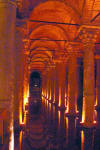

Home Turkey Istanbul Gallipoli Troy Pergamon Ephesus Kusadasi Selcuk Priene Miletos Didyma Hierapolis Aphrodisias
Istanbul - Day 2 - 3rd May
On Day 2, Tuesday 3rd May, we visited the Cisterna Basilica, The Hippodrome, Hagia Sophia (Aya Sofya), the Blue Mosque (Sultan Ahmet-Camii), and the Kariye Müzesi (former Monastery of St Saviour in Chora). We also went into the Grand Bazaar - an area of covered shopping arcades where almost anything can be bought and haggling over price is a must. Lunch was in a fish restaurant on the sea front.
The Cisterna Basilica is an underground water storage cistern built by Emperor Justinius (527-565AD). It is a rectangular structure 140m x 70m. The roof is supported by 12 rows of 28 stone columns, each 9m high. The roof is brick arches to distribute the weight into the columns. The floor and walls were waterproofed with special mortar. This is the second largest cistern in Constantinople and was cleaned and restored in 1985-1987. It was used in the James Bond film From Russia With Love, filmed there in the 1960s.
We explored the site of The Hippodrome, the ancient Roman chariot racing track. The only visible remains are the retaining walls at the one end where the land falls away and the Egyptian Obelisk in the line of the central Spina. There is also a later masonry obelisk and the remains of a bronze serpent column taken from the Temple of Apollo at Delphi. The whole area is now being paved as a public open space.
End wall of Hippodrome Repaving work Plaque Obelisk Marble base [Top of Page]
We visited the Blue Mosque. It is big and has 6 minarets which caused a big outrage (The Great Mosque at Mecca had only 6 so the Sultan was forced to donate a seventh).
We next went to the Hagia Sophia, completed in 537AD under the Emperor Justinian. It was the largest and most important church in the Christian world. The building quickly assumed similar status in Islam after Constantinople was conquered in 1453; 4 minarets were added. The wall and ceiling mosaics were covered over with plaster, which preserved them for posterity. In 1936 Ataturk converted it to a museum and many of the mosaics have been stripped of the plaster to reveal them. The dome, the largest in the world until St Peter's in Rome was built in the 17th century, was built using hollow clay bricks to lighten the weight.
Inside dome view at upper level view from upper level typical mosaic bronze doors from Tarsus marble urn from Pergamon
After a lunch in a sea front fish restaurant we went to visit a former monastery of St Saviour in Chora, now Kariye Müzesi. The wall frescoes were created in 1315-1321 by Grand Logete Theodore Metochites. They are considered to be the finest surviving examples of Byzantine art.
Exterior Ceiling and wall in entrance lobby Dome Typical frescoes